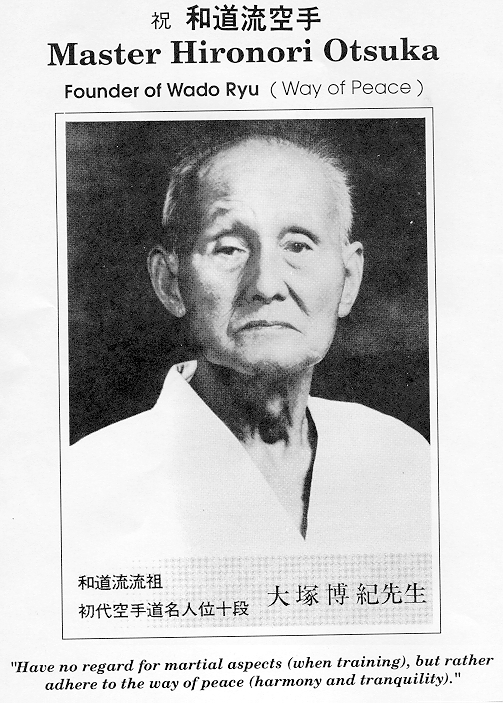top of page
_edited.jpg)
Last training session for 2025 is 21st December. We start back on the 4th January
Burnham & Highbridge Karate Club

Wado-ryu Karate was developed by professor Hironori Ohtsuka, a highly talented budoka born in 1892 in Ibaragi near Tokyo.
A History of Our Sport






Initially Ohtsuka studied Yoshinryu-Jujitsu and showed signs of mastery of the art at an early age. In 1922, upon the advice of a friend, Ohtsuka attended the dojo of Jigaro Kano (the founder of Judo). There he witnessed a demonstration of Karate by Gichin Funakoshi who informed Ohtsuka that it would normally take a budo expert two years to learn the 15 training forms called kata.
Realising the benefits of Funakoshi's teaching and how it may improve his own training in Jujitsu, Ohtsuka began training with Funakoshi and became schooled in the various kata in 18 months. Funakoshi and Ohtsuka were invited to demonstrate Okinawan Karate during a budo gala at the imperial palace. Ohtsuka had previously claimed that particular techniques which existed in the various kata were impractical and inexecutable.
In preparation for the demonstration at the imperial palace, Ohtsuka developed a number of Karate forms for an attacker and defender in accordance with the training models of Jujitsu. The demonstration was a rousing success and sprouted an enormous interest in Karate. Based on his Jujitsu experience Ohtsuka sought to introduce free combat in Karate in addition to the already existing kata and kihon. Funakoshi, completely engulfed and loyal to his traditional Karate teachings, didn't accept Ohtsuka's new vision and the two masters went their separate ways.
Ohtsuka began combining more and more of the various techniques of Jujitsu and Karate and opened his own dojo in Tokyo in 1934. Four years later he gave up his job so as to concentrate on a full-time teaching career. He named his school Wado -Ryu which translates quite simply as 'way of harmony'. However the true expansion of Wado-Ryu, particularly into the university system, did not take place until after the war.
Wado-Ryu is one of the four major Japanese Karate styles and perhaps the purest form of Karate-do. Steeped in classical Bujutsu from his training in Jujitsu and Shindo Yoshin Ryu, Ohtsuka applied this outlook and experience to his teachings. Some of the harsher resistance elements of sparring technique, typical of most Karate styles, are absent in Wado-Ryu. Ohtsuka rejected the hardening of certain body parts, such as the hands, believing such practices were useless as preparation.
The aim of Wado-Ryu in Ohtsuka's original vision is not perfection of physical technique but the development of a mind that is tranquil yet alive, able to react intuitively and without hesitation to any situation. For Ohtsuka, Karate was primarily a spiritual discipline. He once stated: "Violent action may be understood as the way of martial arts, but the true meaning of martial arts is to seek and attain the way of peace and harmony." In Wado, as skill and knowledge are acquired through training and concentrated effort, the student isexpected to develop inner strength and calmness of character, as well as the virtues of self-control, respect for others, and true humility.
Karate-do for Sensei Ohtsuka was primarily a spiritual discipline. Basic techniques - punching, kicking, blocking, striking with open hand, joint twisting, and trapping techniques - kata (a sequence of techniques done in certain order against imaginary opponents), and prearranged and free style sparring comprise the training foundation of this style. Equally fundamental to Wado is taisabaki, body shifting to avoid the full brunt of an attack, a technique derived froact is allowed to the torso. Attacks to the head and torso can all score points in a tournament, therefore, Wado karate-ka tend to fight with explosive, close movements with an emphasis on well-controlled techniques derived from Japanese swordsmanship.
Kumite (sparring) is usually judged on a point system; one referee and four corner judges determine which techniques are given a point. In free sparring, there is no contact allowed to the head, below the waist except for foot sweeps, or to the spine; only light to medium conttact is allowed to the torso. Attacks to the head and torso can all score points in a tournament, therefore, Wado karate-ka tend to fight with explosive, close movements with an emphasis on well-controlled techniques.
In 1972, Ohtsuka Sensei was awarded the title Shodai Karate-do meijin Judan (the greatest title possible) from the Imperial Japanese family. This means first generation karate master of the 10th dan; he was the first Japanese (not Okinawan) to make a style of karate in the form of Japanese budo, thus making it a true Japanese martial art. Master Ohtsuka also received the Shiju Hooshu medal for his outstanding contributions to sport from the government of Japan. He was the only man ever in the history of karate to be so honoured.
bottom of page